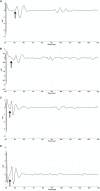Effects of Coil Orientation on Motor Evoked Potentials From Orbicularis Oris
- PMID: 30483044
- PMCID: PMC6243052
- DOI: 10.3389/fnins.2018.00683
Effects of Coil Orientation on Motor Evoked Potentials From Orbicularis Oris
Abstract
This study aimed to characterize effects of coil orientation on the size of Motor Evoked Potentials (MEPs) from both sides of Orbicularis Oris (OO) and both First Dorsal Interosseous (FDI) muscles, following stimulation to left lip and left hand Primary Motor Cortex. Using a 70 mm figure-of-eight coil, we collected MEPs from eight different orientations while recording from contralateral and ipsilateral OO and FDI using a monophasic pulse delivered at 120% active motor threshold. MEPs from OO were evoked consistently for six orientations for contralateral and ipsilateral sites. Contralateral orientations 0°, 45°, 90°, and 315° were found to best elicit OO MEPs with a likely cortical origin. The largest FDI MEPs were recorded for contralateral 45°, invoking a posterior-anterior (PA) current flow. Orientations traditionally used for FDI were also found to be suitable for eliciting OO MEPs. Individuals vary more in their optimal orientation for OO than for FDI. It is recommended that researchers iteratively probe several orientations when eliciting MEPs from OO. Several orientations likely induced direct activation of facial muscles.
Keywords: coil orientation; facial muscle; hand muscle; motor cortex; motor evoked potentials; transcranial magnetic stimulation.
Figures




Similar articles
-
Spread of electrical activity at cortical level after repetitive magnetic stimulation in normal subjects.Exp Brain Res. 2002 Nov;147(2):186-92. doi: 10.1007/s00221-002-1237-z. Epub 2002 Sep 20. Exp Brain Res. 2002. PMID: 12410333
-
Cortical motor representation of the ipsilateral hand and arm.Exp Brain Res. 1994;100(1):121-32. doi: 10.1007/BF00227284. Exp Brain Res. 1994. PMID: 7813640 Clinical Trial.
-
Cortical representation of the orbicularis oculi muscle as assessed by transcranial magnetic stimulation (TMS).Laryngoscope. 2001 Nov;111(11 Pt 1):2005-11. doi: 10.1097/00005537-200111000-00026. Laryngoscope. 2001. PMID: 11801987
-
A comparison between threshold criterion and amplitude criterion in transcranial motor evoked potentials during surgery for supratentorial lesions.J Neurosurg. 2018 Sep 7;131(3):740-749. doi: 10.3171/2018.4.JNS172468. Print 2019 Sep 1. J Neurosurg. 2018. PMID: 30192199
-
Effect of coil orientation on motor-evoked potentials in humans with tetraplegia.J Physiol. 2018 Oct;596(20):4909-4921. doi: 10.1113/JP275798. Epub 2018 Sep 13. J Physiol. 2018. PMID: 29923194 Free PMC article.
Cited by
-
The effects of continuous oromotor activity on speech motor learning: speech biomechanics and neurophysiologic correlates.Exp Brain Res. 2021 Dec;239(12):3487-3505. doi: 10.1007/s00221-021-06206-5. Epub 2021 Sep 15. Exp Brain Res. 2021. PMID: 34524491 Free PMC article.
-
Motor Imagery of Speech: The Involvement of Primary Motor Cortex in Manual and Articulatory Motor Imagery.Front Hum Neurosci. 2019 Jun 11;13:195. doi: 10.3389/fnhum.2019.00195. eCollection 2019. Front Hum Neurosci. 2019. PMID: 31244631 Free PMC article.
-
Reliability of corticospinal excitability and intracortical inhibition in biceps femoris during different contraction modes.Eur J Neurosci. 2023 Jan;57(1):91-105. doi: 10.1111/ejn.15868. Epub 2022 Dec 7. Eur J Neurosci. 2023. PMID: 36382424 Free PMC article.
References
-
- Brasil-Neto J. P., Cohen L. G., Panizza M., Nilsson J., Roth B. J., Hallett M. (1992). Optimal focal transcranial magnetic activation of the human motor cortex: effects of coil orientation, shape of the induced current pulse, and stimulus intensity. J. Clin. Neurophysiol. 9 132–136. 10.1097/00004691-199201000-00014 - DOI - PubMed
LinkOut - more resources
Full Text Sources

